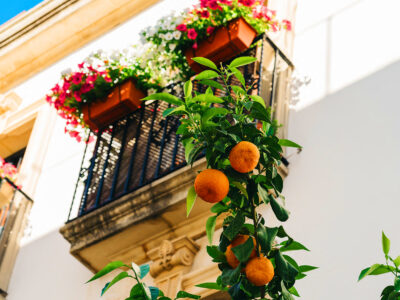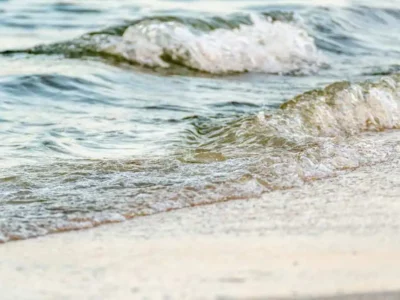
The enchanting sun-soaked region of Andalucia in the South of Spain comprises of eight beautiful provinces Almería, Cádiz, Córdoba, Granada, Huelva, Jaén, Málaga and Seville.
The word “Andalucía” conjures images of whitewashed villages, endless sunshine, and spectacular coastal scenery. It’s the birthplace of many world-renowned artists like Picasso and Velázquez and has become a melting pot of people and cultures, where the continents of Europe and Africa meet. Andalucia is full of interesting, fun, and fascinating people, places, and things. Here are my top ten interesting facts about Spain’s southern region.
1. The worlds largest producer of Olive Oil
Andalucia produces over half the worlds olive oil, some 1.5 million tons annually, enough to fill over 450 Olympic size swimming pools. It’s an integral part of Spanish cuisine that’s been around for 3000 years. The province of Jaén is the biggest producer of olive oil in Spain and produces more of this golden oil than the entire country of Italy.
2. Second Highest Life Expectancy in the World
With an average life expectancy of 83 years such facts about Andalucia as Spain’s longevity, which comes second only after Japan globally, are truly fascinating. Andalucia’s healthy Mediterranean diet and lifestyle are considered to play a significant role in prolonging the lives of its people with women living longer than men, 84 compared to 79. A health and life expectancy study published by the University of Washington suggests Spain by 2040 could enjoy the world’s highest life expectancy with a potential average age of up to 87.4
3. The Birthplace of Tapas
According to legend, back in the 19th century, Alfonso XIII while travelling in Andalucia stopped to rest in a popular tavern in Cadiz. While ordering a glass of wine, the waiter returned with a slice of ham covering the mouth of the glass. The puzzled king quizzed the young waiter who explained he placed the ham as a cover to keep the wind from blowing dust into his drink.
Alfonso was so impressed by the waiters’ piece of ingenuity and enjoyed the little snack so much that he decreed all Taverns should serve Tapas from that day forward. Tapa literally means a “cover” or “a lid”.
4. Only Region in Europe with coastlines on both the Atlantic and Mediterranean
With nearly 1000 km’s of coastline, Andalucia is home to some of the best beaches in Europe. Stretching from the dry and rugged Mediterranean coastline of Almeria in the east, all the way to the golden sandy beaches of Cadiz on the Atlantic coast in the west. The Mediterranean coast in Andalusia consists of the Costa de Almeria, Costa Tropical and the hugely popular. The lovely The lovely Costa del Sol, situated in the Andalusian region of Spain, while the Costa de la Luz runs along the Atlantic seaboard as far as Portugal.
5. The highest concentration of golf courses in Europe
With 110 Golf courses are plentiful in Andalusia, offering a marvelous view of the region of Spain, the region has the highest concentration of courses in continental Europe. Andalucia is also the most visited golf destination in Europe with on average .5 million people coming to Southern Spain each year to play golf. The Andalucía Valderrama Masters reached over 400 million homes on five continents thanks to the European Tour being televised.
6. Largest Desert in Europe
More facts about Southern Spain: Situated North of Almeria, Tabernas desert is the biggest arid desert in Europe. It hardly ever rains on this barren landscape, and temperatures range from between -5 and 48°C. With over 280 square kilometres of protected natural park, the desert has attracted some of the biggest names in Hollywood to shoot classics like “Laurance of Arabia”, “Indiana Jones and the Last Crusade” and “The Good, the Bad and the Ugly”. The rugged terrain, the Cacti and the dusty air feel more like a scene from an American spaghetti western than a part of Andalucia’s Mediterranean coast.
7. Nearly 800 years of Moorish Rule
The Moors from North Africa conquered the region of Andalusia in Southern Spain in the Year 711. The name Andalucia comes from the Arabic name “Al-Andalus” which was the title given to the territory under Muslim control on the Iberian Peninsula until 1492. The Moors improved irrigation systems and helped develop Andalucia’s agricultural sector introducing many new crops like saffron, cotton, sugar cane and rice. At its height, Córdoba, the capital of Moorish territory in Spain, was the most modern city in Europe.
8. Highest Mountain on Mainland Spain
The Mulhacén part of the Sierra Nevada mountain range in the province of Granada is the highest peak on mainland Spain at 3478 metres above sea level. Mulhacén is relatively easy to climb in summer, with a well-marked route that is straightforward to follow. The hike is accessed from the village of Capileira. The mountain is named after the 15th-century Arabic ruler of Granada.
9. Home to the Mediterranean’s only sub-tropical Forest
The Parque Natural Los Alcornocales in Andalucia is the largest cork oak forest in Europe, and one of the biggest in the world. Situated in the province of Cádiz in Andalusia and covering 170,000 hectares, it’s considered one of Europe’s last jungles. Despite its southerly location in Andalusia, the area receives a surprisingly high amount of rainfall – that’s one of the fun facts about this region of Spain. The Forest is home to many wild animals including Wild Boar, Red deer, Ibex, Mongoose, Badgers, and Otters.
10. Sherry is an Anglicized version “Jerez”
Another facts about Southern Spain: Sherry is a wine made from white grapes grown near the town of Jerez de la Frontera in Andalucia. Considered to be one of the oldest wines in the world, the British love affair with Sherry started back in 1587 when Sir Francis Drake plundered Cadiz bringing back 1000’s of barrels to England. Adopted by the English, the name Sherry is an anglicized version of the town named “Jerez”.
Are you looking for property for sale on the Costa del Sol? You are in the right place. Contact me today.
FAQ: Facts about Southern Spain
What are some fascinating facts about Southern Spain?
Southern Spain is home to an incredible mix of cultures, landscapes, and historical significance. From the stunning cities of Sevilla and Córdoba to the fascinating history of Andalusia, there are endless fascinating facts to discover.
What is the significance of the Strait of Gibraltar in Southern Spain?
The Strait of Gibraltar holds immense geopolitical and historical significance. It serves as the gateway between Europe and Africa, and its strategic location has made it a center of trade and cultural exchange for centuries.
What is the role of bullfighting in Southern Spain?
Bullfighting, while controversial, is an integral part of life and culture in Southern Spain. It has a long-standing tradition in the region and holds a significant place in the cultural and historical context of Andalusia.What are some of the notable cities in Southern Spain?
Southern Spain boasts several notable cities, including Sevilla, Córdoba, Granada, and Málaga. Each city offers its own unique blend of history, architecture, and culture that captivates visitors from around the world.
Can you elaborate on the historical significance of Southern Spain during the Reconquest?
Southern Spain played a pivotal role in the period of the Reconquest, during which the Christian kingdoms sought to recapture the Iberian Peninsula from Islamic rule. The region’s history during this time is a fascinating and complex tale of warfare, diplomacy, and cultural exchange.
What are some unique geographical features of Southern Spain?
Southern Spain is characterized by its diverse geographical features, including the majestic Pyrenees, the beautiful Mediterranean coastlines, and the iconic Guadalquivir River. These features contribute to the region’s natural beauty and appeal.
How does Southern Spain’s culture and history intertwine with the Mediterranean Sea?
The Mediterranean Sea has played a significant role in shaping the culture, trade, and historical development of Southern Spain. Its influence can be seen throughout the region in various aspects of life, from cuisine to architecture.
What makes Andalusia an integral part of the cultural tapestry of Southern Spain?
Andalusia, as an autonomous community, is an integral part of the cultural and historical fabric of Southern Spain. Its distinct dialects, traditions, and contributions to the arts and literature have solidified its place as a cornerstone of the region’s identity.
How does Southern Spain’s proximity to the British Overseas Territory of Gibraltar impact the region?
The presence of Gibraltar, a British Overseas Territory, in close proximity to Southern Spain has historical and geopolitical implications for the region. The area has been a source of contention and cooperation throughout history, shaping the cultural and economic dynamics of the region.
What are some lesser-known but fascinating facts about Southern Spain?
From the hours of sunshine that bless the region to the captivating mix of autonomous communities like Extremadura and Castile–La Mancha, there are numerous lesser-known yet intriguing facts that contribute to the allure of Southern Spain.










